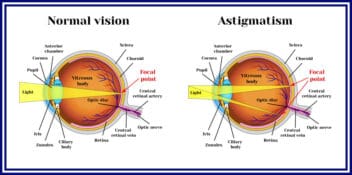
Medically Reviewed by Tom Tooma, M.D., Founder/Medical Director
Can ICLs Correct Astigmatism?
Home / Types of Eye Surgery / ICL Surgery /
Last Updated:

Medically Reviewed by Tom Tooma, M.D., Founder/Medical Director
An ICL can correct astigmatism, providing a permanent treatment option for people with astigmatism as well as myopia.
Table of Contents
ICLs are implanted behind the natural lens of the eye and work by bending light correctly onto the retina, so you can see more clearly.
The ICL implantation process is quick, painless, and offers a speedy recovery. Improved vision is experienced almost immediately.
Visian ICL reports a success rate of 99 percent.
As with any surgery, there are potential risks associated with ICL implantation. Overcorrection or under-correction, halos, night glares, and possibility of infections are some of the potential risks.
ICL implantation provides a reliable treatment option for people with astigmatism.
ICL for Astigmatism

A Toric ICL, known as a Visian Toric Implantable Collamer Lens, is an FDA-approved artificial lens. It can be surgically implanted into the eye to correct for nearsightedness and astigmatism.
The ICL does not replace the natural lens. Instead, it is implanted behind the iris of the eye and in front of the natural lens.
You deserve clear vision. We can help.
With 135+ locations and over 2.5 million procedures performed, our board-certified eye surgeons deliver results you can trust. Your journey to better vision starts here.
For patients with astigmatism, the lens may be appropriate if the following conditions are met:
- The individual is 21 to 45 years old.
- The individual has no cataracts and has never needed cataract surgery.
- There is a need for correction of myopiac of less than or equal to -3.0 D to less than -15.0 D with astigmatism of 1.0 D to 4.0 D at the spectacle plane.
- There is a need for reduction of myopic astigmatism from greater than -15.0 D to -20.0 D with cylinder 1.0 D to 4.0 D at the spectacle plane.
- There is an anterior chamber depth of 3.00 mm or greater.
- There has been a stable refractive history for at least the past year.
The ICL can be used to improve distance vision on its own, as well as distance vision with astigmatism. Toric ICLs can be particularly appealing to people with myopia and astigmatism because an ICL can correct both problems with just one procedure.
How an Implantable Collamer Lens Works

ICLs work to correct refractive errors caused by astigmatism and nearsightedness by changing the way light rays are bent as they enter the eye. The lens correctly bends light that enters the eye and focuses it properly on the retina. The result is clearer distance vision.
ICL implantation can be described as building your contact lenses into your eyes. The soft flexible lens cannot be felt or seen after being implanted. It sits permanently in your eye and corrects your natural focus.
ICLs work with the eye to correct your vision. They are made of collamer, which contains collagen, a material that naturally occurs in the body. Because of the material and flexible structure of the lens, the implant feels natural in your eye. The collamer material also provides UV protection for the eye.
ICL Implantation
The implantation of an ICL is a relatively quick procedure that is typically completed in 30 minutes or less. There are some steps that need to be taken before and after the surgery to ensure a successful procedure.
The timeline of ICL implantation is as follows:
- Two to three weeks before the date of your surgery,your surgeon will perform measurements of your eye and astigmatism to order the customized ICL lens.
- On the day of your surgery, eye drops will be administered to dilate your pupils and anesthetize your eyes.
- During the procedure, a small opening at the base of the cornea will be made. This is where the ICL will be inserted.
- The ICL is then folded and inserted through the small opening. It will then be adjusted to ensure proper positioning and alignment.
Once the lens is in place, you are done with the procedure and should experience improved vision almost right away. No stitches are needed to close the opening, as the cornea will heal on its own. You will be prescribed eye drops to ensure that your eyes stay clean and free from infection as they recover.
You deserve clear vision. We can help.
With 135+ locations and over 2.5 million procedures performed, our board-certified eye surgeons deliver results you can trust. Your journey to better vision starts here.
Success Rates
According to Visian ICL, 99 percent of patients who receive an ICL are satisfied with their results. Over 2 million ICL procedures have been performed around the world. Patients report being able see clearly and in more detail than before surgery.
The ICL is an additive corrective procedure that can be removed or changed if your prescription changes. Additionally, the biocompatible material works with the natural chemistry of the eye to reduce unnatural causes of dry eye that can develop after certain eye surgeries. Unlike with LASIK, the cornea is not altered.
Similar to LASIK, it is important to have realistic expectations going into surgery. An ICL provides correction for refractive errors but may not create perfect vision all the time. Just as with your previous prescription, glasses or contact lenses may still be needed for certain activities.
As your eyes recover following surgery, your vision will continue to improve. It is important not to rub your eyes, though you will be able to return to your normal activities fairly quickly after a week or two.
Possible Risks & Complications
Although ICL implantation is a safe, effective, and FDA-approved procedure, there are still potential risks that must be considered. These are possible risks and complications of a Visian ICL:
- Overcorrection or under-correction
- Halos and night glare
- Infection
- Loss of visual acuity
- Damage to a crystalline lens
- Increase in eye pressure
Speak with your eye doctor about the potential risks and complications of an ICL implantation to determine if the procedure is right for you. Together, you can decide if you are a good candidate for the procedure and if the benefits of an ICL outweigh the potential risks.
Treating Astigmatism
For people with astigmatism, ICL implantation provides a treatment option other than LASIK. LASIK is a well-known procedure for surgically fixing refractive errors causing poor vision, but it is not right for everyone.
People who don’t wish to permanently reshape their cornea to correct their refractive errors may turn to an ICL.
ICLs are highly effective at treating refractive vision errors, including astigmatism. They provide roughly the same vision benefits of wearing contact lenses but without the possible discomfort and restrictions that come with wearing contacts.
You deserve clear vision. We can help.
With 135+ locations and over 2.5 million procedures performed, our board-certified eye surgeons deliver results you can trust. Your journey to better vision starts here.
References
- About Visian ICL. Visian ICL.
- Implantable Collamer Lens. American Academy of Ophthalmology.
- Safety Information: Potential Risks and Complications of the Visian ICL. Visian ICL.
- Visian Toric ICL (Implantable Collamer Lens). (October 2018). U.S. Food & Drug Administration.
- What’s Visian ICL? Visian ICL.

Dr. Tooma, the founder of NVISION® Eye Centers, has performed well over 130,000 LASIK surgeries, making him the most experienced LASIK surgeon in the Western United States.
This content is for informational purposes only. It may have been reviewed by a licensed physician, but is not intended to serve as a substitute for professional medical advice. Always consult your healthcare provider with any health concerns. For more, read our Privacy Policy and Editorial Policy.